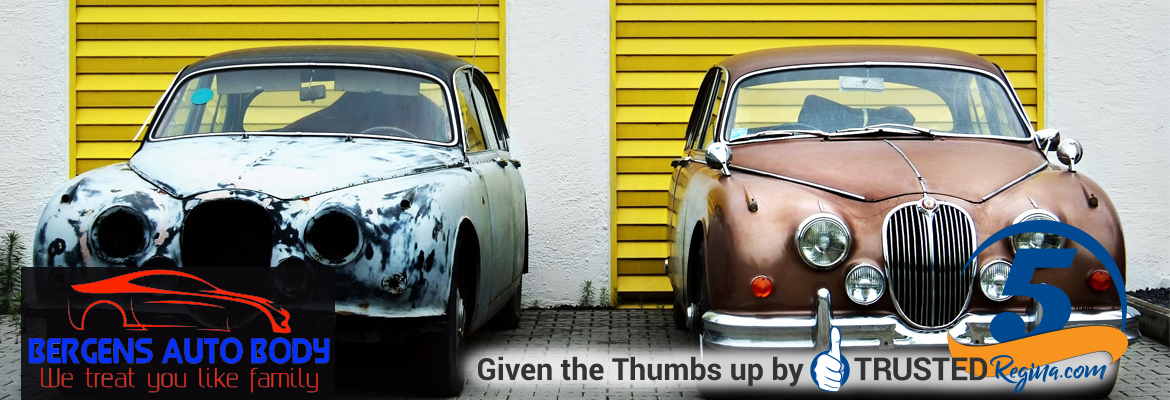Bergens Auto Body is a local family collision repair business and from the moment you walk in the door you will be treated like family!
They are proud to have an amazing 80 Years Auto Body Experience, and they have been serving Regina Auto Body needs for over 30 Years....they have a loyal customer base that simply wouldn't think of going anywhere else. Bergen's Auto Body are a Trusted Regina Auto Body Shop, they offer courtesy cars to their clients and they specialize in foreign vehicles. In their latest Trusted Regina Auto Body Tip they share information on paint matching.
BERGEN'S AUTO BODY SHARE A HANDY BACK TO SCHOOL VEHICLE CHECKLIST
Back to school checklists aren't just for school supplies of books and papers. Bergen's Auto Body also wants to remind you that your vehicle needs to be back to school ready as well.

Are you sending a son or daughter off to University with a car? Or will they be driving to and from high school? Is your carpool schedule starting up, with your kids in the car, plus a few extras? Make sure you have our Back-to-School checklist for your vehicle completed as part of your school preparation this year, you’ll be glad you did!
Just a reminder to make sure all maintenance and safety items are checked and ready to go. Look over this checklist and make sure your (or your child’s) car is ready to go!
- Check your oil level and condition. You have heard it before, but we all need a little reminder to keep up the maintenance on our cars (myself included!) This is the most basic maintenance item to check off. If you let go too long, having little to no oil can cause extreme engine damage (often requiring total engine replacement!). All cars need adequate oil to keep moving parts lubricated and to keep engine friction to a minimum, so keep up on your oil changes!
- Headlights and brake lights. Be sure your lights are operational – brake lights that are burned out are a ticketable offence. For safety, you need to be able to see and be seen.
- Brakes. Do they stop your car quickly and immediately? Are you hearing any grinding during braking? Brake pads or shoes (and the rotors or drums that they press against) are a “wear” item and are intended to be replaced when they become thin. Extremely hard brake pads may last a long time, but they can be squeaky and noisy and could wear drums and warp rotors prematurely. Brake pads should be replaced, and rotors machined, periodically to keep them wearing evenly and braking smoothly. Make sure you have them checked by an expert auto technician.
- Tires are your vehicle’s only contact with the road. Will they provide the traction you need to corner and stop in rain or slick road conditions and are they appropriate for the road conditions where you or your student will be driving? Check the tread. If your tread is less than 2/32” the tire should be replaced. Check for correct tire pressure
- Not sure where to find your tire pressure? Look on the sticker on the driver’s side door jamb or in your owner’s manual.

- Check your windshield wiper fluid. Visibility is vital to driving safety – be sure you are able to clean your windshield quickly if you are hit by a big bug or run into dust or (oh no!) snow.
- Fluid levels and condition. Coolant and transmission fluid keeps your engine and transmission cool and lubricated. Levels should be checked periodically to make sure there is adequate fluid with no leaks in the system. Coolant should be changed every 50-100,000 miles (or every 4-5 years). Transmission fluid should be flushed and filled every 40-60,000 miles (please check your Owner’s Manual for recommendations specific to your vehicle). Brake and power steering fluids should also be monitored and topped off or changed as needed.
- Test and clean the battery. Is the battery adequate to start your vehicle consistently, and run all of the electrical systems in your car? Batteries may need to be replaced every 3-5 years and offer little to no warning that they are failing. Check the date of the battery (located on top). Corrosion should periodically be cleaned off battery posts and cables to maintain an amperage level and a good electrical ground.
- Proof of insurance. Make sure your student has the current auto insurance card inside the vehicle or in their wallet or purse. You may want to add Roadside Assistance to the policy if they will be going to University out of town.
- Emergency kit for the car. Get one inside the vehicle if you don’t already have one. Find one with a set of jumper cables included in case a battery fails. Many kits also include instructions printed on the bag for the cables. Or if you have a kit already, be sure that it is updated with any medication, and other first-aid items that may have been used previously. Be sure it is well stocked and with items needed for the part of the country you or your student will be taking the vehicle.

- Jack and spare tire. Be sure they are in the vehicle and the spare is in good shape. You don’t want to need either and find them missing if you have a flat tire. Also, make sure everyone driving knows HOW to change a tire ( and where to find the spare)
Bergen’s Auto Body & Collision Centre, treat you like family and that means w work hard to give your vehicles back to you properly and most importantly safely!
Read more of Bergens Auto body Tips:
